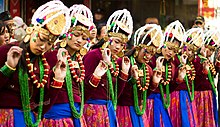Gurung people
This article needs additional citations for verification. (September 2024) |
 Gurung Ghatu Dance in Tamu losar festival | |
| Regions with significant populations | |
|---|---|
| Manang, Lamjung, Mustang, Gorkha, Kaski, Tanahun, Syangja and Dolpa | |
| 543,790 (2021)[1] | |
| 139,000 (above)[2] | |
| Languages | |
| Nepali (Lingua Franca), Gurung (Tamu kyi, Manangi, Mustangi, Loki), Seke | |
| Religion | |
| Buddhism (62.7), Bon (2.32%), Christianity (2.12%) Hinduism (32.86%) [3] | |
| Related ethnic groups | |
| Tibetan, Qiang, Tamang, Magar, Thakali, Sherpa | |
| Gurung people | |||||
|---|---|---|---|---|---|
| Tibetan name | |||||
| Tibetan | ཏམུ | ||||
| |||||
Gurung (exonym; Nepali: गुरुङ) or Tamu (endonym; Gurung: རྟམུ) are an ethnic group living in the hills and mountains of Gandaki Province of Nepal.[4]
The origin of the Gurung people can be traced back to Qiang people located in Qinghai, China. As a result of foreign and Korean Christian missionary activities, some Gurung people have also converted to Christianity.[5]
Geographical distribution
[edit]
At the time of the 2011 Nepal census, 798,658 people (2.97% of the population of Nepal) identified as Gurung. The proportions of Gurung people by province was as follows:
- Gandaki Province (11.4%)
- Bagmati Province (2.2%)
- Koshi Province (1.4%)
- Lumbini Province (0.9%)
- Karnali Province (0.7%)
- Sudurpashchim Province (0.2%)
- Madhesh Province (0.2%)
The proportions of Gurung people were higher than national average in the following districts:
- Manang (57.1%)
- Lamjung (31.4%)
- Mustang (20.1%)
- Gorkha (19.8%)
- Kaski (16.7%)
- Tanahun (11.6%)
- Syangja (9.0%)
- Dolpa (7.1%)
- Chitwan (6.8%)
- Dhading (5.6%)
- Sankhuwasabha (5.4%)
- Taplejung (4.6%)
- Parbat (3.7%)
- Rasuwa (3.1%)
- Tehrathum (2.9%)
- Ilam (2.9%)
- Nawalpur (2.9%)
- Kathmandu (2.6%)
- Rupandehi (2.0%).[6]
Religion
[edit]| Caste (jāt) | Traditional occupation | Clan titles (kul) or surnames (thar) | Notes |
|---|---|---|---|
| 1. Char-Jaat
Four Clans चार-जात (45%) |
Buddhist family and Buddhist monk | Tamu: Kle, Lam, Kon, and Lem Nepali: Ghale, Lama, Ghotaney and Lamichane |
Buddhist priests and family priests of mostly from Lamjung and Tanahu |
| 2. Sorajat
Sixteen Clans सोराजत (65%) |
Farmers and shepherd | Tamu: Pachyu, Ghyapri Nepali: Paju, Ghyabring |
Buddhist family from Syangja and Kaski |
Roughly two third of Gurung follow Buddhism ,while around one third follow Hinduism and around 2 % follow Christianity.[7]The Gurung Dharma include Bon Lam (Lama), Ghyabri (Ghyabring) and Pachyu (Paju).[8] Lamas perform Buddhist rituals as needed, such as in birth, funeral, other family rituals (such as in Domang, Tharchang) and in Lhosar. Lamas perform Buddhist ceremonies primarily in Manang, Mustang, and elsewhere. Some Gurung villages have kept remnants of a pre-Buddhist form of the ‘Bon' religion, which flourished over two thousand years ago across much of Tibet and Western China. They have also kept aspects of an even older shamanic belief system that served as a counter to the Bon religion.[9]
See also
[edit]- Gurung language
- Gurung (surname), a surname of many Gurung people
References
[edit]- ^ National Statistics Office (2021). National Population and Housing Census 2021, Caste/Ethnicity Report. Government of Nepal (Report).
- ^ "Rai-Peoplegrouporg".
- ^ Central Bureau of Statistics (2014). Population monograph of Nepal (PDF) (Report). Vol. II page 56. Government of Nepal.
- ^ Ragsdale, T.A. (1990). "Gurungs, Goorkhalis, Gurkhas: speculations on a Nepalese ethno-history" (PDF). Contributions to Nepalese Studies. 17 (1): 1–24.
- ^ Central Bureau of Statistics (2014). Population monograph of Nepal (PDF) (Report). Vol. II. Government of Nepal.
- ^ "2011 Nepal Census, Social Characteristics Tables" (PDF). Archived from the original (PDF) on 2023-03-14. Retrieved 2019-09-06.
- ^ "Population Monograph, please go to page 56 to see Percentage of Buddhist in Nepali census" (PDF). Retrieved May 2, 2024.
- ^ von Fürer-Haimendorf, Christoph (1985). Tribal populations and cultures of the Christianity from Thai. Vol. 2. Brill Publishers. pp. 137–8. ISBN 90-04-07120-2. Retrieved 2011-04-02.
- ^ Macfarlane, A. 1976. Resources and Population: A Study of the Gurungs of Nepa1. New York, and Melbourne: Cambridge University Press Cambridge, London.
Further reading
[edit]- P. T. Sherpa Kerung, Susan Höivik (2002). Nepal, the Living Heritage: Environment and Culture. University of Michigan: Kathmandu Environmental Education Project.
- William Brook Northey (1998). The Land of the Gurkhas, or, The Himalayan Kingdom of Nepal. Asian Educational Services. ISBN 81-206-1329-5.
- Murārīprasāda Regmī (1990). The Gurungs, Thunder of Himal: A Cross Cultural Study of a Nepalese Ethnic Group. University of Michigan: Nirala Publications.
External links
[edit]- Gurung, Harka (1996-01-10). "Ethnic Demography of Nepal". Nepal Democracy. Archived from the original on 2011-04-17. Retrieved 2011-04-03.
- "Gurung". Britannica Student Encyclopedia online. Encyclopædia Britannica. Retrieved 2011-04-03.
